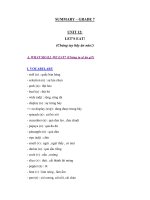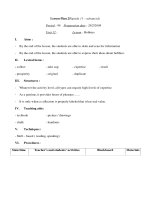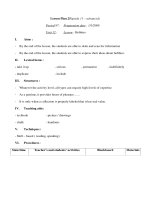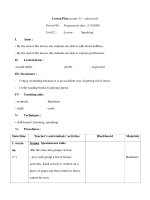Unit 12: MONETARY POLICY
Bạn đang xem bản rút gọn của tài liệu. Xem và tải ngay bản đầy đủ của tài liệu tại đây (273.34 KB, 21 trang )
UNIT 12: MONETARY POLICY
Group 1
Đàm Duy Lương
Đào Thị Thảo Phương
Trần Nam Anh
Hoàng Duy Mạnh
Trần Vũ Huy
I.Vocabulary
Words
Pronounce
Meaning
Reserve requirement
/rɪˈzɜrv rɪˈkwaɪərmənt/
Dự trữ bắt buộc
Money supply
/ˈmʌni səˈplaɪ/
Lượng cung tiền
Discount rate
/ˈdɪskaʊnt reɪt/
Lãi suất chiết khấu
Security
/sɪˈkyʊərɪti/
Chứng khoán
Primary market
/ˈpraɪmɛri ˈmɑrkɪt/
Thị trường sơ cấp
Bond
/bɒnd/
Trái phiếu
Aggregate demand
/ˈægrɪgeɪt dɪˈmænd/
Tổng cầu
Restrictive
/rɪˈstrɪktɪv/
Thắt chặt
II. Reading
A. Quantitative Tools of Monetary Policy
Changing the reserve requirement
By law, the Fed (the Federer Reserve System) controls the percentage of deposits banks keep in reserve by controlling the reserve
requirement of all US banks. The percentage the Fed sets as the minimum amount of resevers as bank must have in called the reserve
requirements. The amount banks must keep in reserve depends on the Fed requirements and partly on how much banks feel they need
for safety (the cash they need to keep on hand at any time to give depositors who claim some of their deposits in the form of cash). The
amount of banks need for safety is much smaller than what the Fed requires. For them, it’s the Fed’s reserve requirements that
determines the amount they hold as reserves. Thus, the reserve requirement play a central role in how much money banks have to lent
out. By changing the reserve requirements, the Fed can increase or decrease the money supply. If the Fed increases the reserve
requirement, it contracts the money supply; banks have keep more reserves so they have less money to lend out.
II. Reading
A. Quantitative Tools of Monetary Policy
Changing the reserve requirement
Thay đổi dự trữ bắt buộc
By law, the Fed (the Federer Reserve System) controls the percentage
Theo luật pháp, Fed (Cục dự trữ liên bang) kiểm soát phần trăm tiền
of deposits banks keep in reserve by controlling the reserve
gửi ngân hàng dự trữ bằng cách kiểm soát dự trữ bắt buộc ở tất cả các
requirement of all US banks. The percentage the Fed sets as the
ngân hàng Mỹ. Phần trăm mà Fed đặt ra là mức dự trữ tối thiểu mà
minimum amount of resevers as bank must have in called the reserve
các ngân hàng phải có được gọi là tỷ lệ dự trữ bắt buộc. Số tiền các
requirements. The amount banks must keep in reserve depends on the
ngân hàng phải dự trữ phụ thuộc vào yêu cầu của Fed và một phần là
Fed requirements and partly on how much banks feel they need for
số tiền các ngân hàng cảm thấy cần phải dự trữ (số tiền mặt họ cần có
safety (the cash they need to keep on hand at any time to give
sẵn bất cứ thời điểm nào để trả cho người gửi, những người yêu cầu
depositors who claim some of their deposits in the form of cash).
rút một phần tiền gửi của họ thành tiền mặt).
II. Reading
A. Quantitative Tools of Monetary Policy
The amount of banks need for safety is much smaller than what
Số tiền mà các ngân hàng cần để dự trữ nhỏ hơn rất nhiều so với
the Fed requires. For them, it’s the Fed’s reserve requirements
con số mà Fed yêu cầu. Với họ, dự trữ bắt buộc của Fed xác định
that determines the amount they hold as reserves. Thus, the
số tiền họ phải dự trữ. Vì vậy, dự trữ bắt buộc đóng một vai trò
reserve requirement play a central role in how much money
trung tâm trong việc các ngân hàng có bao nhiêu tiền để cho vay.
banks have to lent out. By changing the reserve requirements,
Bằng cách thay đổi dự trữ bắt buộc, Fed có thể tăng hoặc giảm
the Fed can increase or decrease the money supply. If the Fed
lượng cung tiền. Nếu Fed tăng dự trữ bắt buộc, nó sẽ ảnh hưởng
increases the reserve requirement, it contracts the money supply;
đến lượng cung tiền; các ngân hàng buộc phải dự trữ nhiều tiền
banks have keep more reserves so they have less money to lend
hơn nên họ sẽ có ít tiền hơn để cho vay.
out.
II. Reading
Question 2: How does the Fed control the percentage of deposits banks keep in reserve?
⇒ The Fed controls the percentage of deposits banks in reserve by controlling the reserve requirement of all US
banks.
Question 3: What is called reserve requirement?
⇒ Reserve requirement is the percentage the Fed sets as the minimum amount of reserves as bank must have.
Question 4: What determines the amount banks hold as reserves?
⇒ The Fed’s reserve requirement determines the amount banks hold as reserves.
Question 5: What is the central role of the reserve requirements?
=> The reserve requirements play a central role in how much money banks have to lend out.
II. Reading
A. Quantitative Tools of Monetary Policy
Changing the Discount rate
A second tool of monetary policy concerns other alternative banks have if they are short of reserves. A bank can go
to its bank (the Fed, the banker’s bank) and take a loan. The discount rate is the rate of interest the Fed charges for
those loans. An increase in the discount rate makes it more expensive for banks to borrow from the Fed. A discount
rate decrease makes it less expensive for bank to borrow. Therefore changing the discount rate is the second way the
Fed can expand or contract the money supply.
II. Reading
A. Quantitative Tools of Monetary Policy
Question 6: What is the second tool of monetary policy?
⇒ Changing the Discount rate.
Question 7: What is the discount rate?
=> The discount rate is the rate of interest the Fed charges for those loans.
II. Reading
A. Quantitative Tools of Monetary Policy
Changing the Discount rate
Thay đổi lãi suất chiết khấu
A second tool of monetary policy concerns other alternative
Công cụ thứ hai của chính sách tiền tệ quan tâm đến lựa chọn
banks have if they are short of reserves. A bank can go to its
khác của các ngân hàng khi thiếu dự trữ. Một ngân hàng có thể
bank (the Fed, the banker’s bank) and take a loan. The discount
tìm đến Fed (ngân hàng của các ngân hàng) để vay tiền. Lãi suất
rate is the rate of interest the Fed charges for those loans. An
chiết khấu là mức lãi suất Fed đặt ra cho các khoản vay. Việc
increase in the discount rate makes it more expensive for banks
tăng mức lãi suất chiết khấu làm cho chi phí đi vay từ Fed của
to borrow from the Fed. A discount rate decrease makes it less
các ngân hàng đắt đỏ hơn. Việc giảm mức lãi suất chiết khấu làm
expensive for bank to borrow. Therefore changing the discount
chi phí đi vay của các ngân hàng giảm đi. Vì vậy việc thay đổi
rate is the second way the Fed can expand or contract the money
lãi suất chiết khấu là cách thứ 2 mà Fed có thể nới rộng hoặc thu
supply.
hẹp lượng cung tiền.
II. Reading
A. Quantitative Tools of Monetary Policy
Open market operations
Changes in discount rate and reserve requirement are not used in day-to-day Fed operations. They are used
mainly for major changes. For day-to-day Fed operations, the Fed used a third tool: open market operations – the
Fed’s buying and selling government securities (the only type of asset the Fed is allowed by law to hold in any
appreciate quantity). These open market operations are the primary tool of monetary policy. When the Fed sells
Treasury bonds, it collects back some of its IOUs, reducing banking system reserves and decreasing the money
supply. Thus, to expand the money supply, the Fed buys bonds. To contract the money supply, the Fed sells
bonds.
II. Reading
A. Quantitative Tools of Monetary Policy
Open market operations
Nghiệp vụ thị trường mở
Changes in discount rate and reserve requirement are not used in day-to-
Thay đổi tỷ lệ chiết khấu và dự trữ bắt buộc không được Fed sử dụng
day Fed operations. They are used mainly for major changes. For day-
liên tục. Họ sử dụng 2 công cụ này chủ yếu cho những biến động lớn.
to-day Fed operations, the Fed used a third tool: open market operations
Đối với hoạt động hàng ngày của Fed, Fed sử dụng công cụ thứ ba:
– the Fed’s buying and selling government securities (the only type of
nghiệp vụ thị trường mở - mua và bán chứng khoán chính phủ (Loại tài
asset the Fed is allowed is allowed by law to hold in any appreciate
sản duy nhất của Fed được phát luật cho phép nắm giữ ở bất kì số lượng
quantity). These open market operations are the primary tool of
nào). Những hoạt động thị trường mở là công cụ chủ yếu của chính
monetary policy. When the Fed sells Treasury bonds, it collects back
sách tiền tệ. Khi Fed bán trái phiếu kho bạc, họ thu lại một số chứng từ
some of its IOUs, reducing banking system reserves and decreasing the
nợ, giảm dự trữ bắt buộc cho hệ thống ngân hàng và giảm cung tiền.
money supply. Thus, to expand the money supply, the Fed buys bonds.
Như vậy, để tăng cung tiền, Fed mua trái phiếu. Để giảm cung tiền, Fed
To contract the money supply, the Fed sells bonds.
bán trái phiếu.
II. Reading
A. Quantitative Tools of Monetary Policy
Question 1: What is the monetary policy?
=> Monetary policy is a policy which controls a nation’s money supply and supervised by
Central Bank.
II. Reading
B. The central bank’s control over the supply of money
The central bank’s control over the supply of money is the key mechanism of monetary policy. By making more or less money
available, the central bank can shift aggregate demand. The resulting shifts can alter the rate of output, the price level, and the number
of availble jobs.
We earlier saw how fiscal policy can help bring about the desired expansion. Were the government to increase its own spending,
aggregate demand would shift to the right. A tax cut would also stimulate aggregate demand by giving consumers and business more
disposable income to spend.
Expansionary monetary policy
Monetary policy may be used to shift aggregate demand as well. If the central bank lowers reserve requirements, drops the discount
(bank) rate, or buy more bond, it will increase bank lending capacity. The banks in turn will try to use that expanded capacity and make
more loans. By offering lower interest rates or easier approvals, the banks can encourage people to borrow and spend more money. In
this way, an increase in the money supply will result in a rightward shift of the aggregate demand curve.
II. Reading
B. The central bank’s control over the supply of money
The central bank’s control over the supply of money is the key
mechanism of monetary policy. By making more or less money
available, the central bank can shift aggregate demand. The resulting
shifts can alter the rate of output, the price level, and the number of
availble jobs.
Sự kiểm soát của ngân hàng trung ương qua mức cung tiền là cơ chế
chính của chính sách tiền tệ. Bằng việc tạo ra nhiều hay ít hơn
lượng tiền có sẵn, ngân hàng trung ương có thể thay đổi tổng cầu.
Kết quả của việc thay đổi có thể làm thay đổi tiền ra bên ngoài, mức
độ giá cả, số lượng việc làm. Chúng ta có thể thấy rõ hơn cách mà
We earlier saw how fiscal policy can help bring about the desired
chính sách tài khóa có thể mang đến sự mở rộng. Được chính phủ
expansion. Were the government to increase its own spending,
tăng các khoản nợ chỉ tiêu, tổng cầu sẽ dịch chuyển sang phải. Một
aggregate demand would shift to the right. A tax cut would also
đợt cắt giảm thuế sẽ kích thích tổng cầu bằng cách đưa người tiêu
stimulate aggregate demand by giving consumers and business more
dùng và nhà kinh doanh nhiều hơn quyền sử dụng thu nhập để chi
disposable income to spend.
tiêu.
II. Reading
B. The central bank’s control over the supply of money
Expansionary monetary policy
Monetary policy may be used to shift aggregate demand as well. If the
central bank lowers reserve requirements, drops the discount (bank)
rate, or buy more bond, it will increase bank lending capacity. The
banks in turn will try to use that expanded capacity and make more
loans. By offering lower interest rates or easier approvals, the banks
can encourage people to borrow and spend more money. In this way,
an increase in the money supply will result in a rightward shift of the
aggregate demand curve.
Chính sách tiền tệ mở rộng
Chính sách tiền tệ có thể được sử dụng để thay đổi tổng cầu. Nếu ngân
hàng trung ương giảm tỷ lệ dự trữ bắt buộc, hạ lãi suất chiết khấu hoặc
mua nhiều trái phiếu, nó sẽ làm tăng lượng vốn cho vay. Ngân hàng sẽ cố
gắng mở rộng nguồn vốn và cho vay nhiều hơn. Bằng cách cung cấp mức
lãi suất thấp hơn hoặc dễ dàng chấp nhận, ngân hàng có thể khuyến khích
người dân mượn tiền, và chi tiêu nhiều hơn. Bằng cách này, lượng cung
tiền tăng sẽ là kết quả trong việc làm đường cầu dịch chuyển sang phải.
II. Reading
B. The central bank’s control over the supply of money
Question 8: How can the central bank shift aggregate demand?
⇒Central bank shifts aggregate demand by making more or less money available?
Question 9: How can the banks encourage people to borrow and spend more money?
=> By offering lower interest rates or easier approvals, the banks can encourage people to
borrow and spend more money.
II. Reading
B. The central bank’s control over the supply of money
Restrictive monetary policy
Monetary policy may be used to cool an overheating economy. Excessive aggregate demand may put too much pressure on our
production capacity. As market participaint bid against each other for increasingly scarce goods, prices will start rising.
The resulting inflation will redistribute real incomes (perhaps unfairly) and may dirupt investment and consumption plans.
The goal of monetary policy in this situation is reduce aggregate demand. To do this, the central bank can reduce the money supply by
(1) raising reserve requirements, (2) increasing the discount rate, or (3) selling bonds in the open market. All of these actions will
reduce bank lending capacity. The combination of higher interest rates and lessened loan availability will curtail investment
consumoption, and even government expenditure.
II. Reading
B. The central bank’s control over the supply of money
Restrictive monetary policy
Chính sách tiền tệ thắt chặt
Chính sách tiền tệ cũng có tác dụng làm hạ nhiệt nền kinh tế đang tăng trưởng quá
Monetary policy may be used to cool an overheating economy. Excessive
aggregate demand may put too much pressure on our production capacity. As
market participaint bid against each other for increasingly scarce goods, prices will
start rising.
nóng. Tổng cầu dư gây lên sức ép đối với khả năng sản xuất. Khi người tham gia thị
trường bắt đầu tăng giá các mặt hàng khan hiếm thì sẽ dẫn đến giá cả tăng.
Hậu quả lạm phát sẽ phân phối lại thu nhập chính (có thể không công bằng) và phá
vỡ các dự án đầu tư và chi tiêu.
The resulting inflation will redistribute real incomes (perhaps unfairly) and may
Mục tiêu của chính sách tiền tệ tronng tình hình này là giảm cầu. Để làm được điều
disrupt investment and consumption plans.
đó, Ngân Hàng Trung Ương có thể giảm cung tiền bằng cách (1) tăng tỉ lệ dự trữ bắt
The goal of monetary policy in this situation is reduce aggregate demand. To do
this, the central bank can reduce the money supply by (1) raising reserve
requirements, (2) increasing the discount rate, or (3) selling bonds in the open
market. All of these actions will reduce bank lending capacity. The combination of
higher interest rates and lessened loan availability will curtail investment
consumoption, and even government expenditure.
buộc, (2) tắng lãi suất chiết khấu, hoặc (3) phát hành trái phiếu trên thị trường mở.
Những cách trên sẽ làm giảm đi khả năng cho vay của các Ngân Hàng Thương Mại.
Các quý cho vay giảm sẽ dẩn tới đẩy lãi suất lên. Cùng với lãi suất được đẩy lên cao
hơn và khả năng cho vay giảm đi sẽ dẫn đến đầu tư và chi tiêu chính phủ sẽ bị hạn
chế.
II. Reading
B. The central bank’s control over the supply of money
Question 10: What is the difference between expensionary monetary policy and restrictive monetary policy?
Expensionary Monetary policy
Restrictive Monetary policy
Goal
Making the economy grow
Cooling the overheating economy
Central bank’s action
Lower reserve requirements
Higher reserve requirements
Drop the discount rate
Increase the discount rate
Buy more bonds
Sell bonds
II. Reading
B. The central bank’s control over the supply of money
Question 11: When will prices begin rising?
⇒ As market participants bid against each other for increasingly scare goods, prices will start rising.
Question 12: What can the central bank do to reduce aggregate demand?
⇒ The central bank can readuce the money supply by raising reserve requirements, increasing the discount
rate, or selling bonds in the open market.
Question 13: When might the central bank want to reduce the money supply?
=>The central bank want to reduce to the money supply in case of an overheating economy.
III. Summary
Monetary policy is a policy which controls a nation’s money supply and supervised by Central Bank.
There are 3 tools of monetary policy:
–
Changing the reserve requirement: is the percentage the Fed sets as the minimum amount of reserves as bank must have. By changing the reserve
requirements, the Fed can increase or decrease the money supply.
–
Changing the discount rate: rate is the rate of interest the Fed charges for those loans. An increase in the discount rate makes it more expensive for banks to
borrow from the Fed. A discount rate decrease makes it less expensive for bank to borrow.
–
Open market operations: the Fed’s buying and selling government securities. To expand the money supply, the Fed buys bonds. To contract the money
supply, the Fed sells bonds.
There are 2 types of monetary policy
–
Expensionary monetary policy: If the central bank lowers reserve requirements, drops the discount (bank) rate, or buy more bond, the money supply will
result in a rightward shift of the aggregate demand curve.
–
Restrictive monetary policy: If the central bank raises reserve requirements, increases the discount rate, or sells bonds in the open market. The central bank
will reduce to the money supply in case of an overheating economy.









